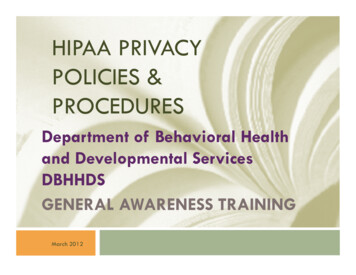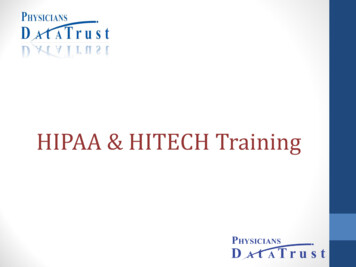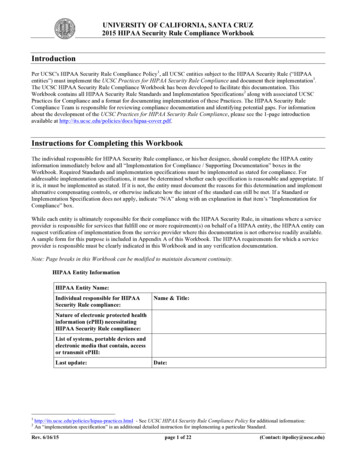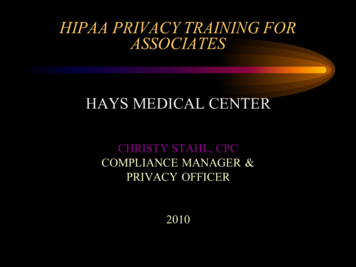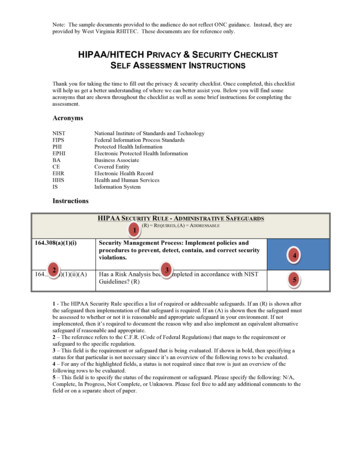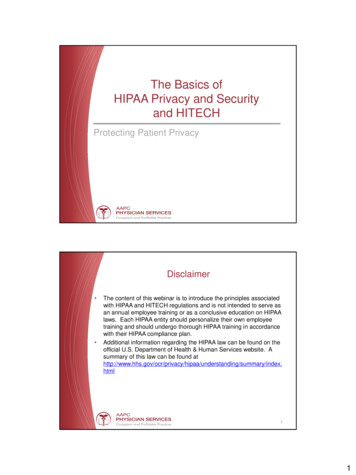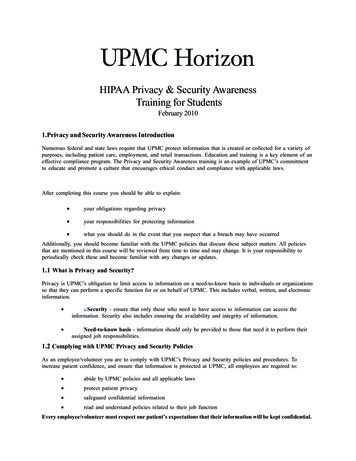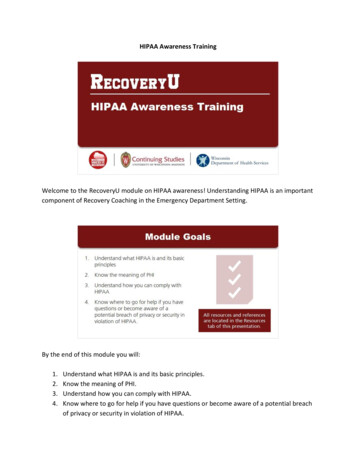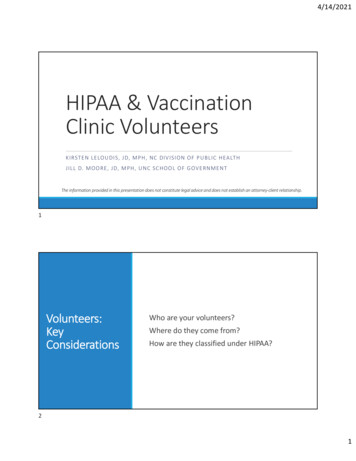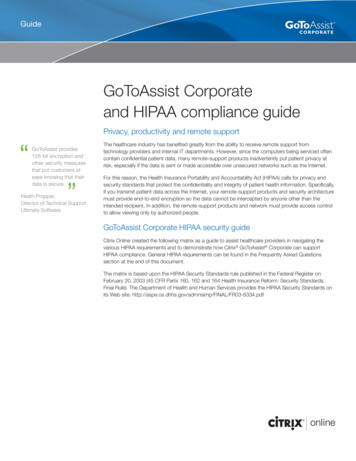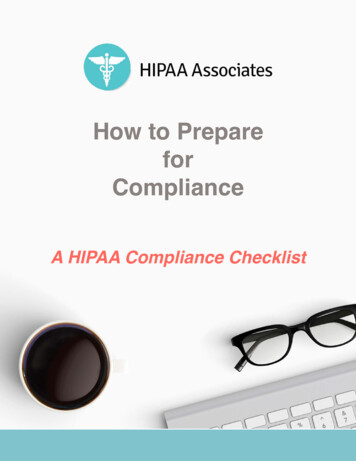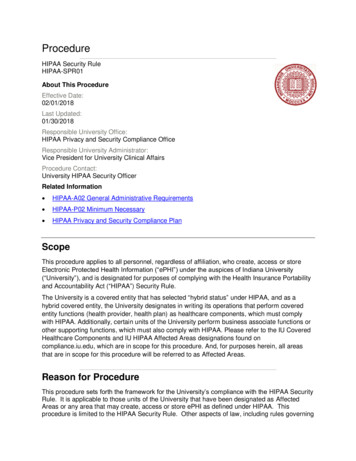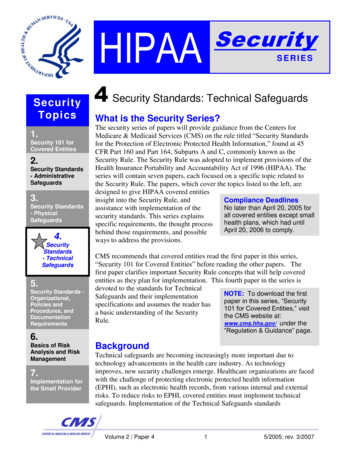
Transcription
SecurityHIPAASecurityTopics1.Security 101 forCovered Entities2.Security Standards- AdministrativeSafeguards3.Security Standards- PhysicalSafeguards4.SecurityStandards- TechnicalSafeguards5.Security Standards Organizational,Policies andProcedures, andDocumentationRequirementsSERIES4 Security Standards: Technical SafeguardsWhat is the Security Series?The security series of papers will provide guidance from the Centers forMedicare & Medicaid Services (CMS) on the rule titled “Security Standardsfor the Protection of Electronic Protected Health Information,” found at 45CFR Part 160 and Part 164, Subparts A and C, commonly known as theSecurity Rule. The Security Rule was adopted to implement provisions of theHealth Insurance Portability and Accountability Act of 1996 (HIPAA). Theseries will contain seven papers, each focused on a specific topic related tothe Security Rule. The papers, which cover the topics listed to the left, aredesigned to give HIPAA covered entitiesinsight into the Security Rule, andCompliance DeadlinesNo later than April 20, 2005 forassistance with implementation of theall covered entities except smallsecurity standards. This series explainshealth plans, which had untilspecific requirements, the thought processApril 20, 2006 to comply.behind those requirements, and possibleways to address the provisions.CMS recommends that covered entities read the first paper in this series,“Security 101 for Covered Entities” before reading the other papers. Thefirst paper clarifies important Security Rule concepts that will help coveredentities as they plan for implementation. This fourth paper in the series isdevoted to the standards for TechnicalNOTE: To download the firstSafeguards and their implementationpaper in this series, “Securityspecifications and assumes the reader has101 for Covered Entities,” visita basic understanding of the Securitythe CMS website at:Rule.www.cms.hhs.gov/ under the“Regulation & Guidance” page.6.Basics of RiskAnalysis and RiskManagement7.Implementation forthe Small ProviderBackgroundTechnical safeguards are becoming increasingly more important due totechnology advancements in the health care industry. As technologyimproves, new security challenges emerge. Healthcare organizations are facedwith the challenge of protecting electronic protected health information(EPHI), such as electronic health records, from various internal and externalrisks. To reduce risks to EPHI, covered entities must implement technicalsafeguards. Implementation of the Technical Safeguards standardsVolume 2 / Paper 415/2005: rev. 3/2007
4 Security Standards: Technical SafeguardsHIPAA SECURITYSTANDARDSSecurity Standards:General Rules---ADMINISTRATIVESAFEGUARDSSecurity ManagementProcessAssigned SecurityResponsibilityWorkforce SecurityInformation AccessManagementSecurity Awarenessand TrainingSecurity IncidentProceduresContingency PlanEvaluationBusiness AssociateContracts and OtherArrangementsPHYSICALSAFEGUARDSFacility AccessControlsWorkstation UseWorkstation SecurityDevice and MediaControlsTECHNICALSAFEGUARDSAccess ControlAudit ControlsIntegrityPerson or EntityAuthenticationTransmission SecurityORGANIZATIONALREQUIREMENTS- Business AssociateContracts & OtherArrangements- Requirements forGroup Health PlansPOLICIES andPROCEDURES andDOCUMENTATIONREQUIREMENTSrepresent good business practices for technology and associated technicalpolicies and procedures within a covered entity. It is important, andtherefore required by the Security Rule, for a covered entity to comply withthe Technical Safeguard standards and certain implementationspecifications; a covered entity may use any security measures that allow itto reasonably and appropriately do so.The objectives of this paper are to: Review each Technical Safeguards standard and implementationspecification listed in the Security Rule. Discuss the purpose for each standard. Provide sample questions that covered entities may want toconsider when implementing the Technical Safeguards.Sample questions provided in this paper, and other HIPAA Security Seriespapers, are for consideration only and are not required for implementation.The purpose of the sample questions is to promote review of a coveredentity’s environment in relation to the requirements of the Security Rule.The sample questions are not HHS interpretations of the requirements of theSecurity Rule.What are Technical Safeguards?The Security Rule defines technical safeguards in § 164.304 as “thetechnology and the policy and procedures for its use that protect electronicprotected health information and control access to it.”As outlined in previous papers in this series, the Security Rule is based onthe fundamental concepts of flexibility, scalability and technologyneutrality. Therefore, no specific requirements for types of technology toimplement are identified. The Rule allows a covered entity to use anysecurity measures that allows it reasonably and appropriately to implementthe standards and implementation specifications. A covered entity mustdetermine which security measures and specific technologies are reasonableand appropriate for implementation in its organization.45 CFR § 164.306(b), the Security Standards: General Rules, Flexibility ofApproach, provides key guidance for focusing compliance decisions,including factors a covered entity must consider when selecting securityVolume 2 / Paper 425/2005: rev. 3/2007
4 Security Standards: Technical Safeguardsmeasures such as technology solutions. In addition, theresults of the required risk analysis and risk managementprocesses at §§ 164.308(a)(1)(ii)(A) & (B) will also assist theentity to make informed decisions regarding which securitymeasures to implement.NOTE: For more informationabout Risk Analysis and RiskManagement, see paper 6 inthis series, “Basics of RiskAnalysis and RiskManagement.”The Security Rule does not require specific technologysolutions. In this paper, some security measures and technical solutions are provided as examplesto illustrate the standards and implementation specifications. These are only examples. Thereare many technical security tools, products, and solutions that a covered entity may select.Determining which security measure to implement is a decision that covered entities must makebased on what is reasonable and appropriate for their specific organization, given their ownunique characteristics, as specified in § 164.306(b) the Security Standards: General Rules,Flexibility of Approach.Some solutions may be costly, especially for smaller coveredentities. While cost is one factor a covered entity mayconsider when deciding on the implementation of a particularsecurity measure, it is not the only factor. The Security Ruleis clear that reasonable and appropriate security measuresmust be implemented, see 45 CFR 164.306(b), and that theGeneral Requirements of § 164.306(a) must be met.NOTE: A covered entity mustestablish a balance betweenthe identifiable risks andvulnerabilities to EPHI, the costof various protective measuresand the size, complexity, andcapabilities of the entity, asprovided in § 164.306(b)(2).STANDARD§ 164.312(a)(1)Access ControlThe Security Rule defines access in § 164.304 as “the ability or the means necessary to read,write, modify, or communicate data/information or otherwise use any system resource. (Thisdefinition applies to “access” as used in this subpart, not as used in subpart E of this part [theHIPAA Privacy Rule]).” Access controls provide users with rights and/or privileges to accessand perform functions using information systems, applications, programs, or files. Accesscontrols should enable authorized users to access the minimum necessary information needed toperform job functions. Rights and/or privileges should be granted to authorized users based on aset of access rules that the covered entity is required toimplement as part of § 164.308(a)(4), the Information AccessNOTE: For more informationManagement standard under the Administrative Safeguardson Information Accesssection of the Rule.Management, see paper 2 inthis series, “Security Standards– Administrative Safeguards.”The Access Control standard requires a covered entity to:Volume 2 / Paper 435/2005: rev. 3/2007
4 Security Standards: Technical Safeguards“Implement technical policies and procedures for electronic informationsystems that maintain electronic protected health information to allowaccess only to those persons or software programs that have been grantedaccess rights as specified in § 164.308(a)(4)[Information AccessManagement].”A covered entity can comply with this standard through a combination of access control methodsand technical controls. There are a variety of access control methods and technical controls thatare available within most information systems. The Security Rule does not identify a specifictype of access control method or technology to implement.Regardless of the technology or information system used,access controls should be appropriate for the role and/orfunction of the workforce member. For example, evenworkforce members responsible for monitoring andadministering information systems with EPHI, such asadministrators or super users, must only have access to EPHIas appropriate for their role and/or job function.NOTE: For a discussion on“required“ and “addressable”Implementation Specifications,see the first paper in this series,“Security 101 for CoveredEntities.”Four implementation specifications are associated with the Access Controls standard.1.2.3.4.Unique User Identification (Required)Emergency Access Procedure (Required)Automatic Logoff (Addressable)Encryption and Decryption (Addressable)1. UNIQUE USER IDENTIFICATION (R) - § 164.312(a)(2)(i)The Unique User Identification implementation specification states that a covered entitymust:“Assign a unique name and/or number for identifying and tracking useridentity.”User identification is a way to identify a specific user of an information system, typicallyby name and/or number. A unique user identifier allows an entity to track specific useractivity when that user is logged into an information system. It enables an entity to holdusers accountable for functions performed on information systems with EPHI whenlogged into those systems.The Rule does not describe or provide a single format for user identification. Coveredentities must determine the best user identification strategy based on their workforce andVolume 2 / Paper 445/2005: rev. 3/2007
4 Security Standards: Technical Safeguardsoperations. Some organizations may use the employee name or a variation of the name(e.g. jsmith). However, other organizations may choose an alternative such asassignment of a set of random numbers and characters. A randomly assigned useridentifier is more difficult for an unauthorized user (e.g., a hacker) to guess, but may alsobe more difficult for authorized users to remember and management to recognize. Theorganization must weigh these factors when making its decision. Regardless of theformat, unlike email addresses, no one other than the user needs to remember the useridentifier.Sample questions for covered entities to consider: Does each workforce member have a unique user identifier? What is the current format used for unique user identification? Can the unique user identifier be used to track user activity withininformation systems that contain EPHI?2. EMERGENCY ACCESS PROCEDURE (R) - § 164.312(a)(2)(ii)This implementation specification requires a covered entity to:“Establish (and implement as needed) procedures for obtaining necessaryelectronic protected health information during an emergency.”These procedures are documented instructions and operational practices for obtainingaccess to necessary EPHI during an emergency situation. Access controls are necessaryunder emergency conditions, although they may beNOTE: Like many of thevery different from those used in normal operationalTechnical Safeguardscircumstances. Covered entities must determine theimplementation specifications,types of situations that would require emergencycovered entities may alreadyaccess to an information system or application thathave emergency accesscontains EPHI.procedures in place.Procedures must be established beforehand to instructworkforce members on possible ways to gain access to needed EPHI in, for example, asituation in which normal environmental systems, such as electrical power, have beenseverely damaged or rendered inoperative due to a natural or manmade disaster.Volume 2 / Paper 455/2005: rev. 3/2007
4 Security Standards: Technical SafeguardsSample questions for covered entities to consider: Who needs access to the EPHI in the event of an emergency?Are there policies and procedures in place to provide appropriate access toEPHI in emergency situations?3. AUTOMATIC LOGOFF (A) - § 164.312(a)(2)(iii)Where this implementation specification is a reasonable and appropriate safeguard for acovered entity, the covered entity must:“Implement electronic procedures that terminate an electronic sessionafter a predetermined time of inactivity.”As a general practice, users should logoff the system they are working on when theirworkstation is unattended. However, there will be times when workers may not have thetime, or will not remember, to log off a workstation. Automatic logoff is an effectiveway to prevent unauthorized users from accessing EPHI on a workstation when it is leftunattended for a period of time.Many applications have configuration settings for automatic logoff. After apredetermined period of inactivity the application will automatically logoff the user.Some systems that may have more limited capabilities may activate an operating systemscreen saver that is password protected after a period of system inactivity. In either case,the information that was displayed on the screen is no longer accessible to unauthorizedusers.Sample questions for covered entities to consider: Do current information systems have an automatic logoff capability?Is the automatic logoff feature activated on all workstations with access toEPHI?4. ENCRYTION AND DECRYPTION (A) - § 164.312(a)(2)(iv)Where this implementation specification is a reasonable and appropriate safeguard for acovered entity, the covered entity must:“Implement a mechanism to encrypt and decrypt electronic protectedhealth information.”Volume 2 / Paper 465/2005: rev. 3/2007
4 Security Standards: Technical SafeguardsEncryption is a method of converting an originalNOTE: The goal of encryptionmessage of regular text into encoded text. The text is is to protect EPHI from beingencrypted by means of an algorithm (i.e., type ofaccessed and viewed byprocedure or formula). If information is encrypted,unauthorized users.there would be a low probability that anyone otherthan the receiving party who has the key to the code or access to another confidentialprocess would be able to decrypt (i.e., translate) the text and convert it into plain,comprehensible text.There are many different encryption methods and technologies to protect data from beingaccessed and viewed by unauthorized users.Sample questions for covered entities to consider: STANDARD§ 164.312(b)Which EPHI should be encrypted and decrypted to prevent access bypersons or software programs that have not been granted access rights?What encryption and decryption mechanisms are reasonable and appropriateto implement to prevent access to EPHI by persons or software programsthat have not been granted access rights?Audit ControlsThe next standard in the Technical Safeguards section is Audit Controls. This standard has noimplementation specifications. The Audit Controls standard requires a covered entity to:“Implement hardware, software, and/or procedural mechanisms thatrecord and examine activity in information systems that contain or useelectronic protected health information.”Most information systems provide some level of audit controls with a reporting method, such asaudit reports. These controls are useful for recording and examining information system activity,especially when determining if a security violation occurred.It is important to point out that the Security Rule does not identify data that must be gathered bythe audit controls or how often the audit reports should be reviewed. A covered entity mustconsider its risk analysis and organizational factors, such as current technical infrastructure,hardware and software security capabilities, to determine reasonable and appropriate auditcontrols for information systems that contain or use EPHI.Volume 2 / Paper 475/2005: rev. 3/2007
4 Security Standards: Technical SafeguardsSample questions for covered entities to consider: STANDARD§ 164.312(c)(1)What audit control mechanisms are reasonable and appropriate to implementso as to record and examine activity in information systems that contain oruse EPHI?What are the audit control capabilities of information systems with EPHI?Do the audit controls implemented allow the organization to adhere topolicy and procedures developed to comply with the requiredimplementation specification at § 164.308(a)(1)(ii)(D) for InformationSystem Activity Review?IntegrityThe next standard in the Technical Safeguards section is Integrity. Integrity is defined in theSecurity Rule, at § 164.304, as “the property that data or information have not been altered ordestroyed in an unauthorized manner.” Protecting the integrity of EPHI is a primary goal of theSecurity Rule.The Integrity standard requires a covered entity to:“Implement policies and procedures to protect electronic protected healthinformation from improper alteration or destruction.”EPHI that is improperly altered or destroyed can result inNOTE: The integrity of EPHIclinical quality problems for a covered entity, includingcan be compromised by bothpatient safety issues. The integrity of data can betechnical and non-technicalcompromised by both technical and non-technical sources.sources.Workforce members or business associates may makeaccidental or intentional changes that improperly alter or destroy EPHI. Data can also be alteredor destroyed without human intervention, such as by electronic media errors or failures. Thepurpose of this standard is to establish and implement policies and procedures for protectingEPHI from being compromised regardless of the source.There is one addressable implementation specification in the Integrity standard.Volume 2 / Paper 485/2005: rev. 3/2007
4 Security Standards: Technical Safeguards1. MECHANISM TO AUTHENTICATE ELECTRONIC PROTECTED HEALTHINFORMATION (A) - § 164.312(c)(2)Where this implementation specification is a reasonable and appropriate safeguard for acovered entity, the covered entity must:“Implement electronic mechanisms to corroborate that electronicprotected health information has not been altered or destroyed in anunauthorized manner.”In order to determine which electronic mechanisms to implement to ensure that EPHI isnot altered or destroyed in an unauthorized manner, a covered entity must consider thevarious risks to the integrity of EPHI identified during the risk analysis. Once coveredentities have identified risks to the integrity of their data, they must identify securitymeasures that will reduce the risks.Sample questions for covered entities to consider: STANDARD§ 164.312(d)Do existing information systems have available functions or processes thatautomatically check for data integrity such as check sum verification ordigital signatures?Are electronic mechanisms to protect the integrity of EPHI currently used?Person or Entity AuthenticationThe Person or Entity Authentication standard has no implementation specifications. Thisstandard requires a covered entity to:“Implement procedures to verify that a person or entity seeking access toelectronic protected health information is the one claimed.”In general, authentication ensures that a person is in fact whohe or she claims to be before being allowed access to EPHI.This is accomplished by providing proof of identity. Thereare a few basic ways to provide proof of identity forauthentication. A covered entity may:NOTE: Authentication involvesconfirming that users are whothey claim to be. Require something known only to that individual, such as a password or PIN.Volume 2 / Paper 495/2005: rev. 3/2007
4 Security Standards: Technical Safeguards Require something that individuals possess, such as a smart card, a token, or akey. Require something unique to the individual such as a biometric. Examples ofbiometrics include fingerprints, voice patterns, facial patterns or iris patterns.Most covered entities use one of the first two methods of authentication. Many small provideroffices rely on a password or PIN to authenticate the user. If the authentication credentialsentered into an information system match those stored in that system, the user is authenticated.Once properly authenticated, the user is granted the authorized access privileges to performfunctions and access EPHI. Although the password is the most common way to obtainauthentication to an information system and the easiest to establish, covered entities may want toexplore other authentication methods.Sample questions for covered entities to consider: STANDARD§ 164.312(e)(1)What types of authentication mechanisms are currently used?What level or type of authentication is reasonable and appropriate for eachinformation system with EPHI?Are other authentication methods available that may be reasonable andappropriate?Transmission SecurityThe final standard listed in the Technical Safeguards section is Transmission Security. Thisstandard requires a covered entity to:“Implement technical security measures to guard against unauthorizedaccess to electronic protected health information that is being transmittedover an electronic communications network.”In order to determine the technical security measures to implement to comply with this standard,covered entities must review the current methods used to transmit EPHI. For instance, is EPHItransmitted through email, over the Internet, or via some form of private or point-to-pointnetwork? Once the methods of transmission are reviewed, the covered entity must identify theavailable and appropriate means to protect EPHI as it is transmitted, select appropriate solutions,Volume 2 / Paper 4105/2005: rev. 3/2007
4 Security Standards: Technical Safeguardsand document its decisions. The Security Rule allows for EPHI to be sent over an electronicopen network as long as it is adequately protected.This standard has two implementation specifications:1. Integrity Controls (Addressable)2. Encryption (Addressable)1.INTEGRITY CONTROLS (A) - § 164.312(e)(2)(i)Where this implementation specification is a reasonable and appropriate safeguard for acovered entity, the covered entity must:“Implement security measures to ensure that electronically transmittedelectronic protected health information is not improperly modified withoutdetection until disposed of.”Protecting the integrity of EPHI maintained in information systems was discussedpreviously in the Integrity standard. Integrity in this context is focused on making surethe EPHI is not improperly modified during transmission.A primary method for protecting the integrity of EPHI being transmitted is through theuse of network communications protocols. InNOTE: A covered entity shouldgeneral, these protocols, among other things, ensurediscuss reasonable andthat the data sent is the same as the data received.There are other security measures that can provideintegrity controls for EPHI being transmitted over anelectronic communications network, such as data ormessage authentication codes, that a covered entitymay want to consider.appropriate security measuresto protect the integrity of EPHIduring transmission with its ITprofessionals, vendors,business associates, andtrading partners.Sample questions for covered entities to consider: What security measures are currently used to protect EPHI duringtransmission?Has the risk analysis identified scenarios that may result in modification toEPHI by unauthorized sources during transmission?Volume 2 / Paper 4115/2005: rev. 3/2007
4 Security Standards: Technical Safeguards What security measures can be implemented to protect EPHI in transmissionfrom unauthorized access?2. ENCRYPTION (A) - § 164.312(e)(2)(ii)Where this implementation specification is a reasonable and appropriate safeguard for acovered entity, the covered entity must:“Implement a mechanism to encrypt electronic protected healthinformation whenever deemed appropriate.”As previously described in the Access Control standard, encryption is a method ofconverting an original message of regular text into encoded or unreadable text that iseventually decrypted into plain comprehensible text. The Encryption implementationspecification is addressable, similar to the addressable implementation specification at §164.312(a)(2)(iv), which addresses Encryption and Decryption.There are various types of encryption technology available to covered entities. For anencryption strategy to be successful, an organization must consider many factors. Forexample, for encryption technologies to work properly when data is being transmitted,both the sender and receiver must be using the same or compatible technology.Covered entities use open networks such as the Internet and e-mail systems differently.Currently no single interoperable encryption solution for communicating over opennetworks exists. Adopting a single industry-wideencryption standard in the Security Rule would likelyNOTE: There are various typeshave placed too high a financial and technical burdenof encryption technology. Towork properly, both the senderon many covered entities. The Security Rule allowsand the receiver must use thecovered entities the flexibility to determine when,same or compatible technology.with whom, and what method of encryption to use.A covered entity should discuss reasonable and appropriate security measures for theencryption of EPHI during transmission over electronic communications networks withits IT professionals, vendors, business associates, and trading partners.Covered entities must consider the use of encryption for transmitting EPHI, particularlyover the Internet. As business practices and technology change, situations may arisewhere EPHI being transmitted from a covered entity would be at significant risk of beingaccessed by unauthorized entities. Where risk analysis shows such risk to be significant, acovered entity must encrypt those transmissions under the addressable implementationspecification for encryption.Volume 2 / Paper 4125/2005: rev. 3/2007
4 Security Standards: Technical SafeguardsSample questions for covered entities to consider: How does the organization transmit EPHI? How often does the organization transmit EPHI? Based on the risk analysis, is encryption needed to protect EPHI duringtransmission?What methods of encryption will be used to protect the transmission ofEPHI?In SummaryThe Security Rule Technical Safeguards are the technology and related policies and proceduresthat protect EPHI and control access to it. The Technical Safeguards standards apply to allEPHI. The Rule requires a covered entity to comply with the Technical Safeguards standardsand provides the flexibility to covered entities to determine which technical security measureswill be implemented.Together with reasonable and appropriate Administrative and Physical Safeguards, successfulimplementation of the Technical Safeguards standards will help ensure that a covered entity willprotect the confidentiality, integrity and availability of EPHI.Volume 2 / Paper 4135/2005: rev. 3/2007
4 Security Standards: Technical SafeguardsResourcesThe remaining papers in this series will address other specific topics related to the Security Rule.The next paper in this series covers the final sections of the Security Rule, OrganizationalRequirements and Policies and Procedures and Documentation Requirements.Covered entities should periodically check the CMS website at www.cms.hhs.gov under“Regulations and Guidance” for additional information and resources as they work through thesecurity implementation process. There are many other sources of information available on theInternet. While CMS does not endorse guidance provided by other organizations, coveredentities may also want to check with other local and national professional health careorganizations, such as national provider and health plan associations for additional information.Need more information?Visit the CMS website often at www.cms.hhs.gov under “Regulations and Guidance” for thelatest security papers, checklists, and announcements of upcoming events.Visit the Office for Civil Rights website, http://www.hhs.gov/ocr/hipaa, for the latestguidance, FAQs and other information on the Privacy Rule.Volume 2 / Paper 4145/2005: rev. 3/2007
4 Security Standards: Technical SafeguardsSecurity Standards Matrix(Appendix A of the Security Rule)ADMINISTRATIVE ss§ 164.308(a)(1)Assigned SecurityResponsibilityWorkforce Security§ 164.308(a)(2)§ 164.308(a)(3)Information AccessManagement§ 164.308(a)(4)Security Awarenessand TrainingSecurity IncidentProceduresContingency Plan§ 164.308(a)(5)§ 164.308(a)(6)§ 164.308(a)(7)Evaluation§ 164.308(a)(8)Business AssociateContracts and OtherArrangements§ 164.308(b)(1)Volume 2 / Paper 4Implementation Specifications(R) Required, (A) Addressable(R)Risk Analysis(R)Risk Management(R)Sanction Policy(R)Information SystemActivity ReviewAuthorization and/orSupervisionWorkforce ClearanceProcedureTermination ProceduresIsolating Health CareClearinghouse FunctionsAccess AuthorizationAccess Establishmentand ModificationSecurity RemindersProtection from MaliciousSoftwareLog-in MonitoringPassword ManagementResponse and Reporting(A)Data Backup PlanDi
Management 7. Implementation for the Small Provider 1. Covered Entities Policies 2. Security Standards - Administrative Safeguards 3. Security Standards - Physical Safeguards 5. Security Standards - Organizational, and Procedures, and Documentation Requirements 4. Security Standards - Technical Safeguards 4 Security Standards: Technical Safeguards
